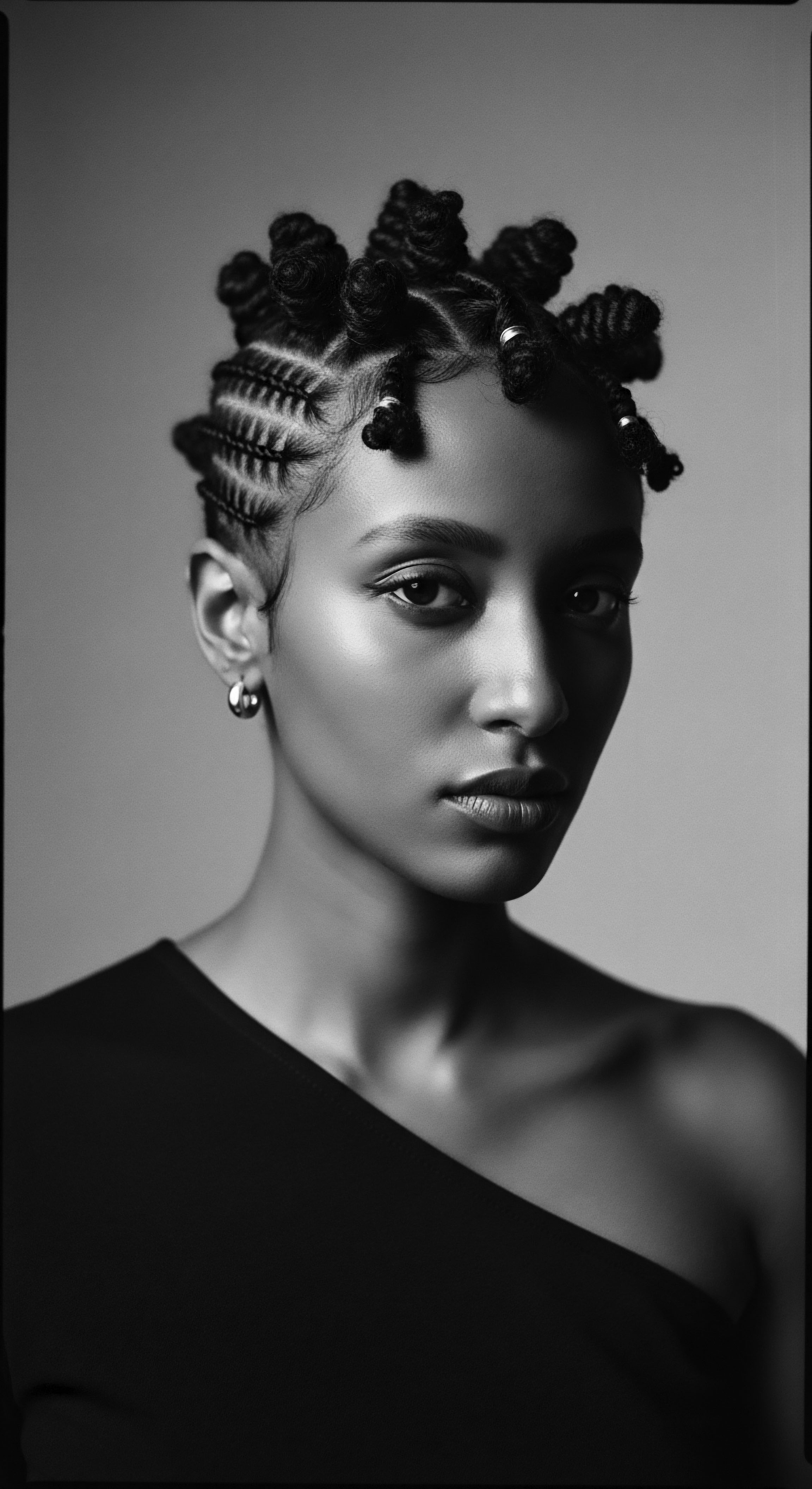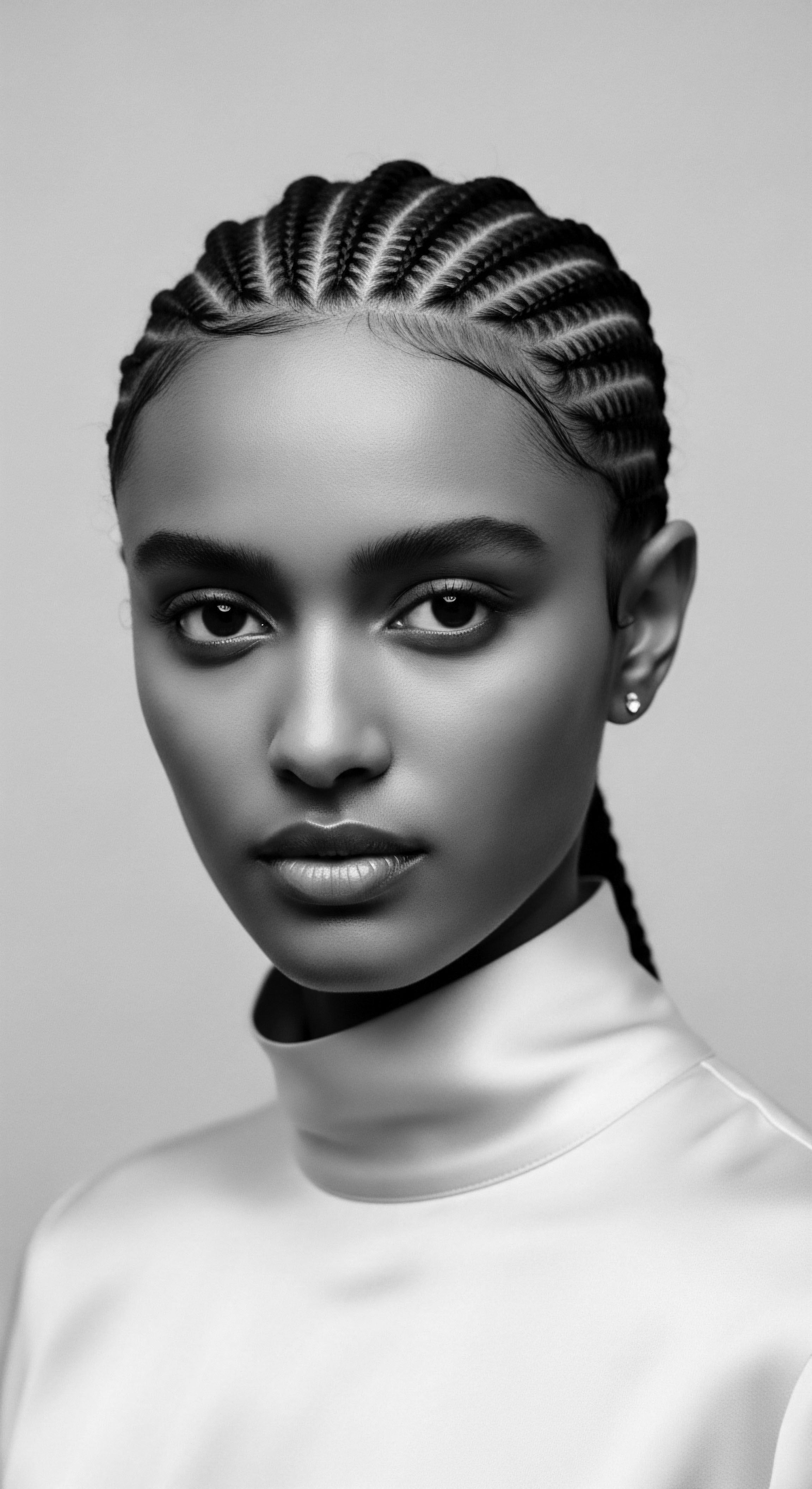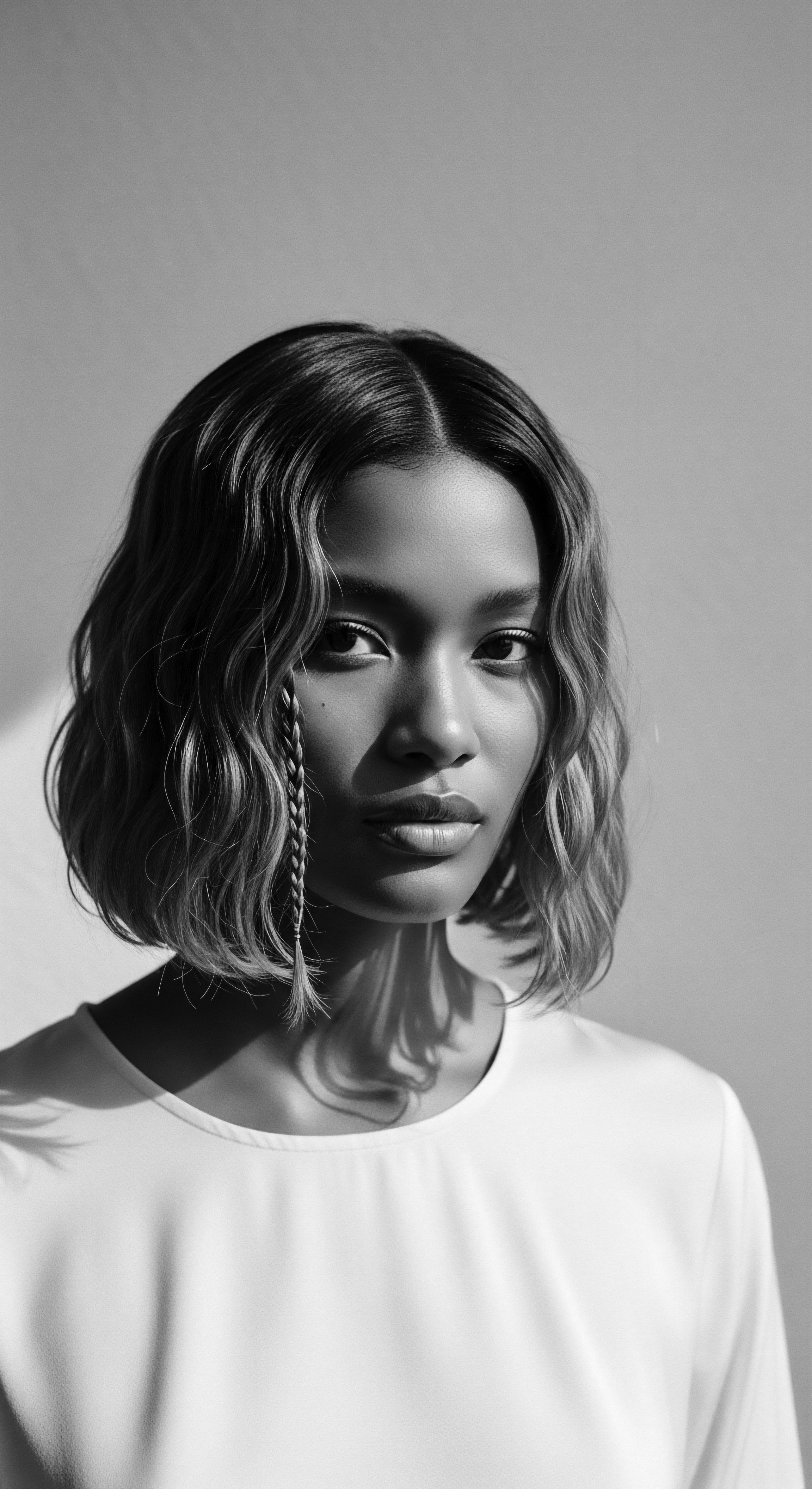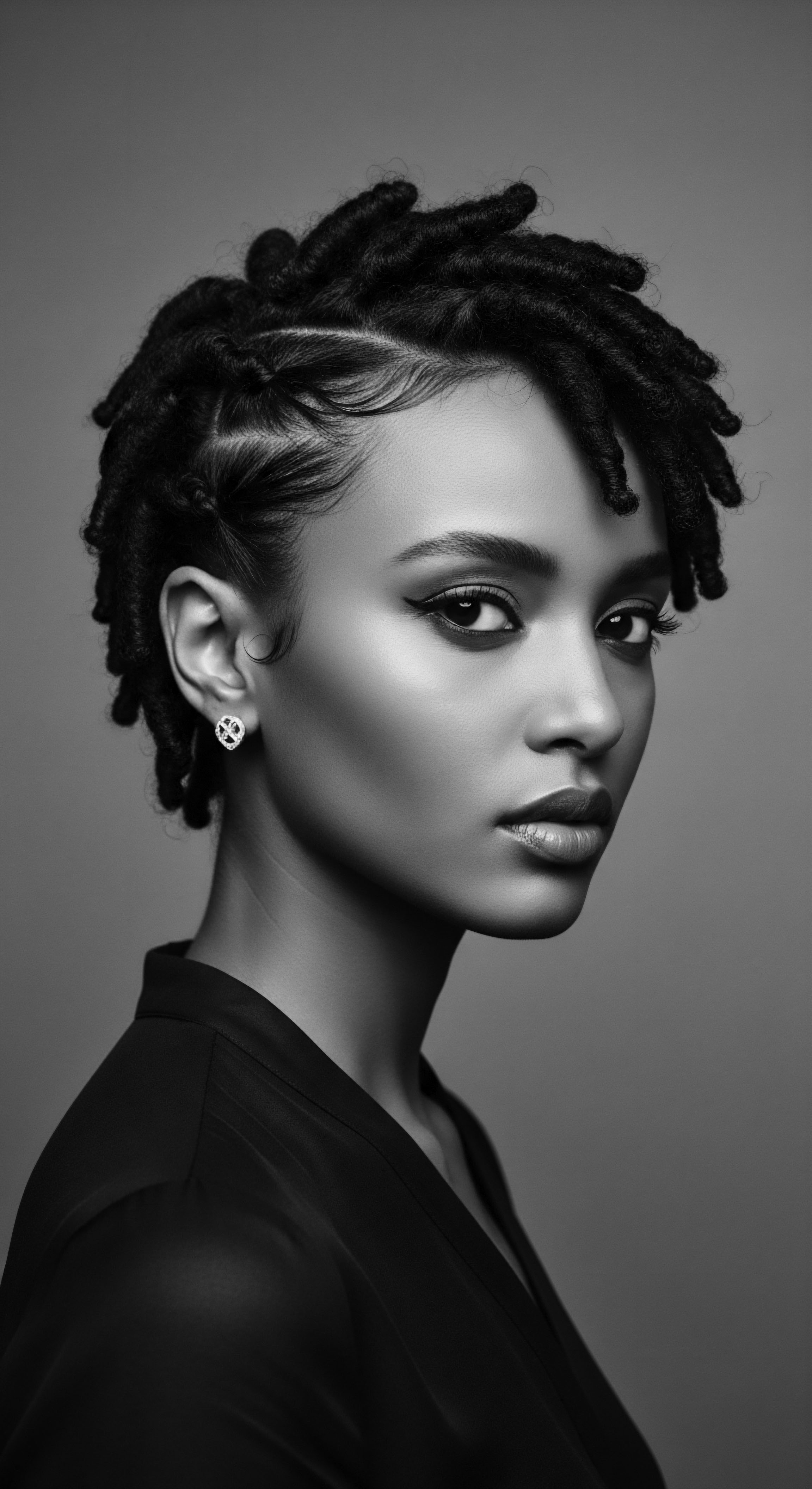
Fundamentals
The term “Traditional Oils” within Roothea’s living library denotes more than simple botanical extracts; it represents a profound ancestral legacy, particularly for textured hair, Black hair, and mixed-race hair communities. At its most elemental, a traditional oil is a lipid-rich substance derived from plants, nuts, or seeds, historically employed for its restorative and protective qualities. Yet, its true meaning extends beyond mere chemical composition, reaching into the very heart of cultural identity and communal well-being.
These oils, often cold-pressed or extracted through time-honored methods, served as foundational elements in daily life, providing nourishment, shielding against environmental harshness, and contributing to ritualistic adornment. The application of these oils was rarely a solitary act; it was frequently a communal practice, fostering bonds and transmitting intergenerational wisdom.
Across diverse ancestral communities, the understanding of these oils was intrinsically linked to their direct experience with the natural world. They recognized the distinctive properties of each oil, observing how certain plant derivatives softened hair, others offered a protective barrier, and still others promoted scalp vitality. This knowledge, gathered over countless generations, formed an empirical science of hair care, long before modern laboratories isolated individual compounds. The deep respect for the source of these oils—the trees and plants themselves—was an inherent part of their traditional use, recognizing the land as a generous provider.
In early historical contexts, the significance of these oils for textured hair cannot be overstated. The unique structural characteristics of coily, kinky, and curly hair types, with their inherent need for moisture and protection, made the lubricating and sealing properties of traditional oils indispensable. From the sun-drenched savannas to the humid Caribbean islands, these natural emollients were a primary defense against dryness and breakage. They helped maintain the hair’s suppleness, enabling intricate styling that communicated social status, tribal affiliation, and personal narratives.
Traditional Oils represent an ancestral legacy, embodying plant-derived lipid-rich substances used historically for restorative and protective qualities, deeply interwoven with cultural identity and communal well-being.

Echoes from the Source ❉ Ancient Practices and Botanical Wisdom
The earliest applications of traditional oils trace back thousands of years, predating written records in many instances, with evidence found in archaeological sites and oral histories. For instance, in ancient Egypt, castor oil held a prominent place in beauty regimens, valued for its moisturizing attributes to condition and fortify hair. Beyond its cosmetic utility, it found purpose in medicinal and even embalming practices, underscoring its versatility within these early societies. The practice of anointing the body with oils was not exclusive to royalty; it diffused through various strata of society, demonstrating a collective recognition of its benefits.
Across the African continent, a vast array of indigenous plants provided the raw materials for these vital oils. The shea tree, Vitellaria paradoxa, native to the Sudano-Sahelian region, yields shea butter, an oil-soluble fat renowned for its moisturizing and healing properties. Its use spans millennia, with archaeological findings suggesting its processing by local residents as early as A.D. 100, far earlier than previously assumed.
This butter was not merely a cosmetic item; it served as a primary cooking oil and a treatment for various ailments, reflecting its integral role in daily life and traditional medicine. The meticulous process of extracting shea butter, often passed down through generations of women, speaks to the deep connection between ancestral knowledge, sustainable practices, and the preservation of communal resources.
Other oils, such as palm oil from the Elaeis guineensis tree, were also widely used in West African kingdoms for skin hydration and hair health, especially in warm climates. These practices were not isolated; they were part of a holistic approach to wellness, where external application supported internal balance. The knowledge of these botanical resources, their preparation, and their specific uses for different hair textures and conditions, formed a sophisticated body of ancestral wisdom.
- Shea Butter ❉ Derived from the shea tree, Vitellaria paradoxa, a staple in West and East African hair care for centuries, valued for its moisturizing and protective qualities, often used in its raw, unrefined form.
- Castor Oil ❉ A thick, nutrient-rich oil with origins in Africa, widely used in ancient Egypt and later introduced to the Caribbean, celebrated for its ability to promote hair growth and scalp health.
- Palm Oil ❉ Sourced from the oil palm tree, Elaeis guineensis, historically utilized in West African communities for skin and hair nourishment, offering deep hydration and a protective barrier.

Intermediate
Moving beyond the fundamental recognition, the intermediate meaning of “Traditional Oils” for textured hair delves into how these heritage practices were not static, but rather dynamic systems, passed down through familial lines and adapted across geographies and historical shifts. This section focuses on the practical application of these oils within evolving hair care rituals and styling practices for Black and mixed-race hair across the diaspora. The essence here is continuity—how the tender thread of ancestral knowledge persisted, even when faced with immense challenges.
Traditional oils became cornerstones of hair care routines, serving not only a functional purpose of conditioning and protecting delicate strands but also a profound cultural one. They were integral to the art of hair manipulation, allowing for the creation of intricate styles like braids, twists, and cornrows, which were themselves powerful expressions of identity and resilience. The lubrication provided by these oils minimized friction and breakage, enabling these protective styles to be worn for extended periods, preserving hair length and health. This understanding of oil’s role in supporting the structural integrity of textured hair, especially its susceptibility to dryness and breakage, was a practical wisdom refined over centuries.

The Tender Thread ❉ Continuity and Adaptation in Hair Care Rituals
The transatlantic slave trade, a period of immense upheaval, saw the forced displacement of millions of Africans, severing many ties to their homelands and traditional practices. Despite these dehumanizing conditions, the ingenuity and resilience of enslaved Africans meant that aspects of their hair heritage, including the use of oils, found ways to persist and adapt. Stripped of their customary tools and resources, they ingeniously utilized available materials, such as animal fats and whatever natural oils they could access, to moisturize and protect their hair from the harsh realities of plantation life.
For example, the journey of castor oil from Africa to the Caribbean serves as a powerful testament to this adaptive heritage. Originally used in ancient Egypt and various African societies for medicinal and cosmetic purposes, the castor plant was transported to the Caribbean by enslaved Africans. There, it became an essential component of traditional beauty and medicine, especially in Jamaica, where it gained prominence as “Jamaican Black Castor Oil.” This oil, produced through a traditional roasting process, became a staple for hair growth, moisturization, and overall hair and scalp vitality within Afro-Caribbean communities. This specific historical trajectory demonstrates how ancestral practices, even under duress, were preserved and re-established, forming new cultural expressions rooted in shared heritage.
The resilience of Traditional Oils lies in their enduring presence within diasporic hair care, where ancestral knowledge was adapted and sustained despite immense historical challenges.
The ritualistic application of these oils extended beyond mere function. On Sundays, often a day of rest, enslaved people would gather to braid each other’s hair, using available greases or oils like butter or goose grease. This act was not simply about styling; it was a communal bonding experience, a moment of shared care and cultural affirmation amidst adversity. These sessions served as conduits for transmitting knowledge, stories, and solidarity, weaving together the physical act of hair care with the emotional and spiritual sustenance of community.
As communities of the diaspora continued to shape their identities, traditional oils remained central. In West African traditions, oils and butters were consistently employed to maintain hair moisture in hot, arid climates, often paired with protective styles to safeguard length and overall hair health. This regional consistency underscores a deep, practical understanding of environmental factors and hair needs, knowledge that traveled and found new expressions in different parts of the world.
| Traditional Oil Shea Butter |
| Ancestral Application (Historical/Cultural Context) Used across West Africa for millennia as a moisturizer and protective agent for hair and skin, often extracted through communal processes. |
| Modern Resonance (Contemporary Use/Benefit) A global staple in conditioners and balms, prized for its deep moisturizing properties, particularly for dry, textured hair, bridging ancient African beauty rituals with current formulations. |
| Traditional Oil Castor Oil |
| Ancestral Application (Historical/Cultural Context) Employed in ancient Egypt for hair conditioning and later introduced to the Caribbean, where it became a foundational ingredient for promoting hair growth and thickness, especially in Jamaican traditions. |
| Modern Resonance (Contemporary Use/Benefit) Celebrated today for its ricinoleic acid content, which aids scalp circulation and robust hair growth, a common component in hair growth serums and treatments for various hair types. |
| Traditional Oil Coconut Oil |
| Ancestral Application (Historical/Cultural Context) A cherished multipurpose oil in tropical regions, including the Caribbean, used for deep hydration and as a protective barrier for hair and skin, often symbolizing heritage. |
| Modern Resonance (Contemporary Use/Benefit) A popular, accessible oil used for its ability to penetrate the hair shaft, reducing protein loss and providing deep conditioning, found in countless hair care products globally. |
| Traditional Oil These oils, rooted in ancestral wisdom, continue to provide valuable benefits for textured hair, affirming the enduring power of heritage in hair care. |

The Evolution of Application ❉ From Raw to Refined
The historical application of traditional oils often involved their raw, unrefined forms, directly massaged into the scalp and strands. Women of Ethiopian and Somali descent, for instance, used a homemade “hair butter” from whipped animal milk and water for hair maintenance, yielding excellent results. Similarly, the Basara Tribe of Chad applied an herb-infused raw oil and animal fat mixture, known as Chebe, to their hair weekly for length retention, a practice involving an intricate, time-consuming process holding deep cultural significance. This direct application allowed for maximum absorption of the natural compounds, a tactile connection to the earth’s offerings.
As societies developed and knowledge diffused, the preparation of these oils became more sophisticated. Herbs and botanicals were often infused into the oils, enhancing their therapeutic properties. This practice, common in Ayurvedic traditions of South Asia and also present in African hair care, aimed to create synergistic blends that addressed specific hair and scalp concerns, from promoting growth to preventing dandruff. The careful selection of botanicals, based on generations of observation and experimentation, reflects a deep understanding of phytochemistry, long before the term existed.
The communal aspect of hair oiling is a recurring theme across cultures. In South Asian households, hair oiling is a generational tradition, with elders massaging oil into the scalps of younger family members. This ritual serves as an act of both hair care and bonding, fostering connections and transmitting cultural values alongside practical knowledge. This shared experience reinforces the idea that hair care is not merely a personal grooming activity but a deeply social and culturally embedded practice.

Academic
The advanced understanding of “Traditional Oils” transcends a mere descriptive explanation; it delves into a compound explication, analyzing their significance within the intricate tapestry of textured hair, Black hair, and mixed-race hair heritage, their ongoing evolution, and their contemporary scientific validation. This layer of comprehension considers the interplay of biological, historical, psychological, and social factors that shape the meaning and application of these oils, offering a profoundly insightful perspective for scholars, researchers, and practitioners. It is here that we bridge ancestral wisdom with rigorous inquiry, revealing the enduring relevance of these ancient practices in a modern context.
From an anthropological perspective, Traditional Oils represent more than cosmetic agents; they are artifacts of cultural continuity, symbols of resistance, and vehicles for transmitting communal memory. During periods of forced assimilation, such as the transatlantic slave trade, the very act of maintaining natural hair with these oils became a subversive assertion of identity. Enslaved individuals, stripped of many cultural markers, clung to hair care practices as a means of preserving a connection to their African ancestry. The knowledge of specific oils and their application became a hidden curriculum, passed down through whispers and touch, safeguarding a lineage of self-care and communal bonding.

The Unbound Helix ❉ Intersections of Biology, History, and Identity
The biological efficacy of Traditional Oils for textured hair types is now increasingly understood through modern scientific lenses, often affirming the intuitive wisdom of ancestral practices. Textured hair, characterized by its elliptical follicle shape and varied curl patterns, possesses a unique architecture that influences its moisture retention and susceptibility to breakage. The coiled structure creates more points of fragility along the hair shaft, and the natural oils produced by the scalp struggle to travel down the full length of these intricate curls, leading to inherent dryness. Traditional oils, with their diverse fatty acid profiles, address these specific biological needs.
For example, shea butter, with its high content of fatty acids like oleic and stearic acids, provides exceptional emollient properties, sealing moisture into the hair shaft and creating a protective barrier against environmental stressors. This aligns with the historical observation of West African communities who utilized it to maintain hair moisture in hot, dry climates. Similarly, castor oil, rich in ricinoleic acid, possesses a unique viscosity and is recognized for its ability to promote circulation to the scalp, thereby supporting healthier hair growth—a scientific explanation for its long-standing reputation as a growth elixir in Caribbean and African traditions.
Traditional Oils are not merely cosmetic; they are living testaments to cultural resilience, embodying ancestral knowledge validated by modern scientific understanding of textured hair biology.
The sociocultural impact of these oils extends into contemporary identity politics. The natural hair movement, gaining momentum in the early 2000s and continuing its ascent, has seen a resurgence in the popularity of Traditional Oils. This movement is not simply about aesthetics; it is a profound reclamation of Black and mixed-race beauty standards, a rejection of Eurocentric ideals that historically marginalized textured hair. Choosing to utilize ingredients like shea butter or Jamaican Black Castor Oil becomes an act of cultural affirmation, a conscious connection to ancestral wisdom and a celebration of one’s unique hair heritage.
Consider the specific historical example of the Himba people of Namibia. Their practice of coating their hair and bodies with a mixture of ochre, butterfat, and herbs, known as “otjize,” is a striking illustration of the multifaceted role of traditional oils. This deep red paste serves as a protective layer against the harsh sun and dry climate, a cleansing agent, and a powerful cultural marker. The consistency of this practice over centuries, despite external influences, speaks to the profound embeddedness of hair care within their cultural identity, social structures, and spiritual beliefs.
The very texture and color of their hair, shaped by this traditional oil mixture, communicate their age, marital status, and social standing within the community. This practice, rigorously documented in anthropological studies, provides a compelling case study of how traditional oils are not merely functional but are integral to the very fabric of a living heritage.

The Scholarly Delineation ❉ A Deeper Understanding
The delineation of Traditional Oils at an academic level necessitates an understanding of their classification beyond simple botanical origin. They can be analyzed through their chemical profiles, examining the dominant fatty acids, vitamins, and antioxidants present, and correlating these with observed benefits. For instance, the varied composition of different shea butter types (e.g.
from West Africa vs. East Africa) can result in differing consistencies and applications, a distinction understood empirically by traditional practitioners and now scientifically validated.
Furthermore, the concept of Traditional Oils encompasses the traditional formulations —the intentional blending of various oils, herbs, and other natural ingredients to create synergistic effects. Moroccan traditions, for example, involve formulations of argan and olive oils with essential oils like thyme, black seed, and garlic for hair care, a practice used for centuries in rural and mountainous regions. This complex interplay of ingredients, each contributing unique properties, highlights a sophisticated traditional pharmacopoeia for hair wellness. The study of cosmetic ethnobotany, which investigates these plant-based beauty practices, offers a rich field for understanding the scientific basis of these ancient remedies.
The implications for future innovation are considerable. By rigorously studying the historical and cultural applications of Traditional Oils, researchers and product developers can draw inspiration from ancestral wisdom to create effective, culturally resonant hair care solutions. This involves not simply replicating ancient practices but understanding the underlying principles and adapting them with contemporary scientific knowledge, always with deep respect for the heritage from which they spring. The commercialization of these oils, such as the global shea butter market valued at over $2 billion in 2022, also raises important ethical considerations regarding fair trade, sustainable sourcing, and ensuring benefits flow back to the communities that have stewarded this knowledge for generations.
- Chemical Composition and Efficacy ❉ Analyzing the specific fatty acid profiles (e.g. oleic, linoleic, ricinoleic acids) and micronutrients (vitamins A, E, antioxidants) within Traditional Oils to understand their biological impact on textured hair’s structure, moisture retention, and scalp health.
- Ethnobotanical and Anthropological Context ❉ Investigating the cultural significance, ritualistic uses, and intergenerational transmission of knowledge surrounding Traditional Oils within specific Black and mixed-race communities, tracing their historical journey and adaptation across the diaspora.
- Sustainability and Ethical Sourcing ❉ Examining the ecological and socio-economic implications of harvesting and processing Traditional Oils, particularly concerning the livelihoods of indigenous communities and the preservation of biodiversity.
- Innovation Grounded in Heritage ❉ Exploring how contemporary hair science and product development can draw inspiration from Traditional Oils and ancestral formulations, creating new solutions that honor cultural wisdom while meeting modern hair care needs.

Reflection on the Heritage of Traditional Oils
The journey through the world of Traditional Oils, from their elemental beginnings to their complex academic meaning, is truly a profound meditation on textured hair, its heritage, and its care. These oils are not mere commodities; they are liquid stories, each drop carrying the whispers of ancestors, the resilience of communities, and the wisdom of the earth. They speak to the ‘Soul of a Strand’ ethos by reminding us that hair care is never solely about external appearance. It is a deeply personal and communal act, connecting us to a lineage of knowledge, survival, and celebration.
The enduring presence of these oils in Black and mixed-race hair experiences underscores a powerful truth ❉ that self-care, when rooted in heritage, becomes a radical act of self-acceptance and cultural affirmation. As we continue to rediscover and honor these time-honored practices, we not only nurture our hair but also nourish our spirits, weaving ourselves into the unbroken chain of ancestral wisdom that continues to guide and protect us.

References
- Sharaibi, O. J. Oluwa, O. K. Omolokun, K. T. Ogbe, A. A. & Adebayo, O. A. (2024). Cosmetic Ethnobotany Used by Tribal Women in Epe Communities of Lagos State, Nigeria. Journal of Complementary Medicine & Alternative Healthcare, 12(4), 555845.
- Gallagher, D. (2016). Researchers get lathered up over Shea butter’s history. OregonNews.
- Sushruta Samhita. (6th Century BCE). Ancient Indian text on medicine and surgery.
- Oforiwa, A. (2023). The History and Culture of African Natural Hair ❉ From Ancient Times to Modern Trends. AMAKA Studio.
- Tharps, L. & Byrd, A. (2001). Hair Story ❉ Untangling the Roots of Black Hair in America. St. Martin’s Press.
- PushBlack. (2023). Why Jamaican Black Castor Oil Is Rich in Black History. PushBlack.
- Clinikally. (2024). Reviving Ancient Hair Rituals ❉ Exploring the Therapeutic Art of Hair-Oiling. Clinikally.
- Cécred. (2025). Understanding Hair Oiling ❉ History, Benefits & More. Cécred.
- Brown History. (2023). The Bonding Ritual of Hair Oiling. Brown History.
- Africa Imports. (2023). Traditional African Secrets For Long And Healthy Hair. Africa Imports.
- Byrdie. (2021). Indian Hair Oiling ❉ The Ancient Secret to Long, Shiny Hair. Byrdie.
- BeautyMatter. (2025). The Untold Story of Jojoba Oil in Black Beauty. BeautyMatter.
- Joanna Colomas. (2023). Unlock Ancient Hair Care Secrets ❉ Discover Global Rituals for Lustrous Locks. Joanna Colomas.
- Mango Butterfull Cosmetics. (2022). What is the purpose of the oil bath? Mango Butterfull Cosmetics.
- Husn Beauty. (2024). From Roots to Beard ❉ How Jamaican Black Castor Oil Transforms Grooming. Husn Beauty.
